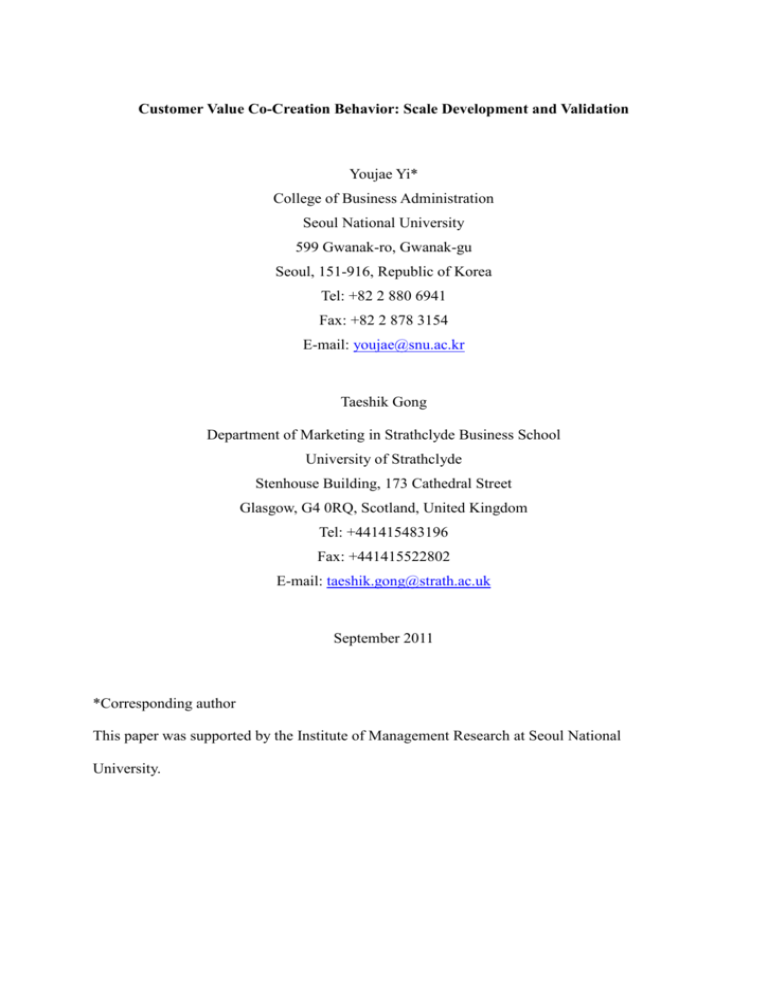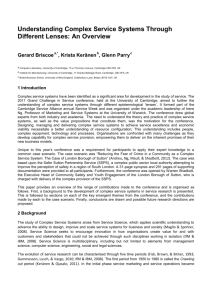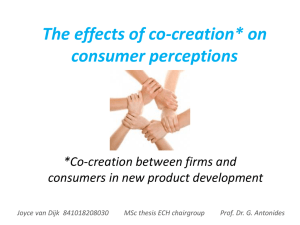
Customer Value Co-Creation Behavior: Scale Development and Validation
Youjae Yi*
College of Business Administration
Seoul National University
599 Gwanak-ro, Gwanak-gu
Seoul, 151-916, Republic of Korea
Tel: +82 2 880 6941
Fax: +82 2 878 3154
E-mail: youjae@snu.ac.kr
Taeshik Gong
Department of Marketing in Strathclyde Business School
University of Strathclyde
Stenhouse Building, 173 Cathedral Street
Glasgow, G4 0RQ, Scotland, United Kingdom
Tel: +441415483196
Fax: +441415522802
E-mail: taeshik.gong@strath.ac.uk
September 2011
*Corresponding author
This paper was supported by the Institute of Management Research at Seoul National
University.
2
Customer Value Co-Creation Behavior: Scale Development and Validation
ABSTRACT
This investigation reports a series of four studies leading to the development and
validation of a customer value co-creation behavior scale. The scale comprises two
dimensions: customer participation behavior and customer citizenship behavior, with each
dimension having four components. The elements of customer participation behavior include
information seeking, information sharing, responsible behavior, and personal interaction,
whereas the aspects of customer citizenship behavior are feedback, advocacy, helping, and
tolerance. The scale is multidimensional and hierarchical, and it exhibits internal consistency
reliability, construct validity, and nomological validity. This study also shows that customer
participation behavior and customer citizenship behavior exhibit different patterns of
antecedents and consequences.
Keywords: customer value, customer participation behavior, customer citizenship
behavior, service-dominant logic, scale development, value co-creation
3
1. Introduction
Practitioners’ and scholars’ interest in the service-dominant (S-D) logic of marketing
has increased sharply in the last decade (Vargo and Lusch, 2004). Although previous
customer behavior literature has focused on the customer decision-making process regarding
purchases, customers are not merely responders but rather active value creators, and scholars
need to focus on customer behavior in this regard (Xie, Bagozzi, and Troye, 2008). The core
concept of S-D logic is that the customer is always a co-creator of value. As active
participants and collaborative partners in relational exchanges, customers co-create value
with the firm through involvement in the entire service–value chain.
To date, few studies have systematically explored the exact nature of dimensionality
of customer value co-creation behavior, leaving its precise composition unclear. Some studies
use a multidimensional approach to capture customer value co-creation behavior and consider
it to consist of many distinctive components (e.g., Bettencourt, 1997; Bove, Pervan, Beatty,
and Shiu, 2008; Groth, 2005), whereas other studies employ a unidimensional approach and
use single- or multiple-item measures (e.g., Cermak, File, and Prince 1994; Dellande, Gilly,
and Graham, 2004; Fang, Palmatier, and Evans, 2008). However, this method ignores the
conceptual richness of the customer value co-creation behavior construct. None of the
previous research explores the relationship between the overall construct and its dimensions.
Therefore, both practitioners and scholars need research that (1) clearly identifies and
measures customers’ behavior in co-creating value, (2) fully validates a comprehensive
customer value co-creation behavior construct, and (3) explores the hierarchical
dimensionality of customer value co-creation behavior. The primary motivation for this study
is thus the development and validation of a scale to measure customer value co-creation
behavior.
4
The present article makes several contributions. First and most important, the scale
will be useful not only in academic research but also in practice. As marketers engage in
projects to understand and improve the value co-creation behaviors of their customers, they
can use the scale for assessing, planning, and tracking purposes. Second, the firm can use the
scale to detect weaknesses and strengths of customer value co-creation behavior. Based on
their customer behavior assessment and business strategies, companies can allocate corporate
resources to the important customer value co-creation aspects uncovered by this study. Third,
the scale could be used for all types of service industries. Unfortunately, the previous related
constructs were not applied to many contexts. In fact, researchers were unable to identify any
broad or abstract category of customer value co-creation attributes. As an alternative, this
study offers a new protocol to measuring customer value co-creation behavior that captures
all related dimensions of customer behavior across different industries.
The current research first defines customer value co-creation behavior and the
dimensions that compose the concept. This research then reports a series of studies that
develop a measure of customer value co-creation behavior and assess the new measure's
reliability and validity.
2. Customer value co-creation behavior and its dimensions
Early research identifies two types of customer value co-creation behavior: customer
participation behavior, which refers to required (in-role) behavior necessary for successful
value co-creation, and customer citizenship behavior, which is voluntary (extra-role) behavior
that provides extraordinary value to the firm but is not necessarily required for value cocreation (Bove et al., 2008; Groth, 2005; Yi and Gong 2008; Yi, Nataraajan, and Gong, 2011).
Empirical evidence shows that in-role and extra-role behaviors follow different patterns and
5
have different antecedents and consequences (Groth, 2005; Yi et al., 2011). Therefore,
researchers should use separate scales for assessing customer participation behavior and
customer citizenship behavior.
This study conceptualizes customer value co-creation behavior as a multidimensional
concept consisting of two higher-order factors, each made up of multiple dimensions. These
two factors are customer participation behavior and customer citizenship behavior. This study
also posits that customer participation behavior comprises four dimensions: information
seeking, information sharing, responsible behavior, and personal interaction. In a similar vein,
this study views customer citizenship behavior as consisting of feedback, advocacy, helping,
and tolerance. This study suggests a hierarchical conceptualization in a third-order factor
model.
This typology parallels the traditional management literature on the distinction
between employee in-role and extra-role behavior. According to Borman and Motowidlo’s
(1993) theoretical framework on partitioning of the individual performance domain,
performance can be divided into task performance and contextual performance. Task
performance involves behaviors that are expected and necessary for the successful
completion of service delivery so that without these behaviors service delivery will be
incomplete. Similar to employees, customers who participate in service delivery should
engage in some behavior such as information seeking, information sharing, responsible
behavior, and personal interaction, which are classified as customer participation behavior in
this study. For example, customers seek information to perform their expected behaviors
without which value co-creation could not be completed successfully. Meanwhile, contextual
performance involves voluntary and discretionary behaviors that are not required for the
successful value co-creation. In this regard, customers do not have to exhibit behaviors such
6
as feedback, advocacy, help, and tolerance for the successful completion of service cocreation.
2.1. Customer participation behavior
Information seeking. According to Kellogg, Youngdahl, and Bowen (1997),
customers seek information to clarify service requirements and satisfy other cognitive needs.
More specifically, customers want information about service status and service parameters.
Customers need information about how to perform their tasks as value co-creators as well as
what they are expected to do and how they are expected to perform during a service
encounter. Providing this information reduces customer uncertainty regarding value cocreation with employees. Just as employees acquire the task, role knowledge, and behaviors
needed to participate as organizational members, customers seek to understand the nature of
service and their roles in the value co-creation process (Kelley, Donnelly, and Skinner, 1990;
Kellogg et al., 1997).
Information seeking is important to customers for two primary reasons. First,
information reduces uncertainty and thereby enables customers to understand and control
their co-creation environments. Second, information seeking enables customers to master
their role as value co-creators and become integrated into the value co-creation process.
Customers can seek information from the firm in a number of ways. For example, customers
might directly ask another person for information or they can monitor the behavior of
experienced customers to obtain informational cues (Kelley et al., 1990; Morrison, 1993).
Information sharing. For successful value co-creation, customers should provide
resources such as information for use in value co-creation processes (Lengnick-Hall, 1996). If
customers do not provide essential information, employees cannot even begin or perform
7
their duties. Through sharing information with employees, customers can ensure that
employees provide the service that meets their particular needs (Ennew and Binks, 1999). For
example, taking the car in for service, customers need to give the mechanic information about
strange noises or vibrations. Or when ordering a cake for a special occasion, customers
should provide adequate information for the flavor and design. Patients should provide the
physician with proper information about their condition so that the physician can make an
accurate diagnosis. If customers fail to provide accurate information, the quality of value cocreation may be low. Thus, information sharing is the key to the success of value co-creation.
Responsible behavior. Responsible behavior occurs when customers recognize their
duties and responsibilities as partial employees (Ennew and Binks, 1999). For successful
value co-creation between themselves and employees, customers need to be cooperative,
observing rules and policies and accepting directions from employees (Bettencourt, 1997).
For example, customers must follow the employees’ directives and be physically present for
the successful value co-creation. Without customers’ responsible behavior, little value cocreation occurs in the service encounter.
Personal interaction. Personal interaction refers to interpersonal relations between
customers and employees, which are necessary for successful value co-creation (Ennew and
Binks, 1999). Kelley et al. (1990) use the term customer functional quality to refer to the
interaction between customers and employees, which includes interactional aspects such as
courtesy, friendliness, and respect. Value co-creation in a service context takes place in a
social setting; the more pleasant, congenial, and positive the social environment is, the more
likely customers are to engage in value co-creation (Lengnick-Hall, Claycomb, and Inks,
2000).
8
2.2. Customer citizenship behavior
Feedback. Feedback includes solicited and unsolicited information that customers
provide to the employee, which helps employees and the firm to improve the service creation
process in the long run (Groth, Mertens, and Murphy, 2004). Customers are in a unique
position to offer guidance and suggestions to employees, because customers have
considerable experience with the service and are experts from the customer perspective
(Bettencourt, 1997). Customers are on the receiving end of employees’ behavior, and the firm
can benefit greatly from customers’ suggestions for better service. While feedback from
customers can be valuable, it clearly constitutes an extra-role behavior and is not a requisite
for successful service delivery.
Advocacy. Advocacy refers to recommending the business—whether the firm or the
employee—to others such as friends or family (Groth et al., 2004). In the context of value cocreation, advocacy indicates allegiance to the firm and promotion of the firm’s interests
beyond the individual customer’s interests (Bettencourt, 1997). Advocacy through positive
word-of-mouth is often an indicator of customer loyalty, and it contributes greatly to the
development of a positive firm reputation, promotion of the firm’s products and services,
higher service quality evaluations, and increase in the customer base size (Bettencourt, 1997;
Groth et al., 2004). Like other customer citizenship behaviors, advocacy is completely
voluntary and not mandatory for successful value co-creation.
Helping. Helping refers to customer behavior aimed at assisting other customers. In a
service co-creation process, customers usually direct helping behavior at other customers
rather than at employees because other customers in a service encounter may need help
behaving in ways consistent with their expected roles (Groth et al., 2004). Unlike the roles of
employees, the roles of customers are less defined and role-scripted, placing customers in a
9
situation that can require spontaneous help from other customers (Groth et al., 2004).
Rosenbaum and Massiah (2007) also argue that customers might extend empathy to other
customers through helping behaviors. They note that customers recall their own difficult
experiences and display a sense of social responsibility to help other customers experiencing
similar difficulties.
Tolerance. Tolerance refers to customer willingness to be patient when the service
delivery does not meet the customer’s expectations of adequate service, as in the case of
delays or equipment shortages (Lengnick-Hall et al., 2000). Because service encounter failure
is the second largest cause of customer switching behavior, which damages market share and
profitability of the firm, customer tolerance will plausibly help the firm in the aggregate
overall (Keaveney, 1995).
3. Scale development
3.1. Study 1: Item generation
This research generated an initial pool of more than 100 items from a review of
previous literature and exploratory in-depth interviews. In the interviews, 15 students and five
adult customers were asked to describe in an open-ended format the behaviors they exhibit
during a service encounter. The purpose of the in-depth interviews was to uncover specific
characteristics of customer value co-creation behavior. The interviews were transcribed,
analyzed, and converted into items.
Following development of this original set of statements, the items were screened to
eliminate any items that were ambiguous, redundant, and otherwise faulty, which resulted in
72 items. Seven marketing faculty and Ph.D. students then evaluated these 72 items. After
reading the definition of each dimension of customer value co-creation behavior, a related
10
explanation, and an example of the behavior, they assigned the items to one of the eight
dimensions or to a “not applicable” category. An item was retained if at least six of the judges
chose the same category (Bearden, Netemeyer, and Teel, 1989; Tian, Bearden, and Hunter,
2001). Additional four judges rated how well each of the 72 items reflects the different
dimensions of customer value co-creation behavior, using the following scale: 1= clearly
representative, 2=somewhat representative, and 3 = not at all representative. For the eight
dimensions, this study retained only items that three judges evaluated as clearly
representative and that a fourth judge evaluated as somewhat representative (Bearden et al.,
2001; Tian et al., 2001; Zaichkowsky, 1985). This process eliminated 28 items, leaving 44
items.
3.2. Study 2: Item purification
In an effort to determine the factor structure of customer value co-creation behavior
and purify the measurement tool on the basis of its psychometric properties, this research
collected survey data from 296 undergraduate and graduate student customers. The average
age of the respondents was 23.5 years, and 41% were male. All respondents were asked to
recall their most recent encounter within the last three months from experiences with service
providers across several industries (e.g., retailing, full-service restaurant, hair salons, health
care facilities, and travel) and multiple-service providers in each industry, and then to answer
questions about their behavior as customers. To enhance recall of the particular encounter, a
number of open-ended questions requested respondents to provide details on the type of
service provided and their overall service experience.
This study first examined corrected item-to-total correlations and item correlations
for each set of items representing customer co-creation behavior, and then deleted items that
had corrected item-to-total correlations below .50 and item correlations below .20 (Bearden et
11
al., 2001; Bearden et al., 1989; Zaichkowsky, 1985). This research then evaluated the
remaining items using exploratory factor analysis (principal components factor analysis with
varimax rotation). An iterative process eliminated items that had a factor loading below .50,
high cross-loadings above .40, and low commonalities below .30 (Hair, Black, Babin, and
Anderson, 2009). The final factor analysis resulted in eight factors with eigenvalues
exceeding 1 and explained 77.91% of the total variance. Cronbach’s alpha values for the eight
dimensions ranged from .79 to .93, all exceeding the .70 cut-off value recommended by
Nunnally (1994). The Kaiser-Meyer Olkin (KMO) value of .82 and a significant chi-square
value for the Bartlett's test of sphericity (χ 2 = 2303.74, p< .001) indicated that factor analysis
was appropriate for the data. Table 1 presents the final list of items retained for confirmatory
factor analysis.
Table 1 here.
3.3. Study 3: Reliability assessment and construct validation
To evaluate the reliability and validity of the scale, this study recruited and trained
researchers to serve as data collectors for Study 3. They contacted respondents face-to-face
and gave the self-administered questionnaire. This data collection procedure yielded 311
responses. Of the respondents, 52% were male. About 43.2% of the respondents belonged to
the age group of 21 to 30, 42.3% were in the 31 to 40 age group, and the remainder(14.4%)
were 41 years old and above. Most of the respondents were currently employed (82.9%).
Dimensionality and reliability. To assess the dimensionality of the constructs, this
study performed confirmatory factor analysis using Mplus 5.21 (Muthén and Muthén, 2009).
Figure 1A shows the results for the CFA model. The results confirm the dimensionality of the
29-item, eight-dimension scale (χ 2(349) = 535.59, p< .001, CFI = .94, TLI = .93, RMSEA
= .06, SRMR = .04). This study also assessed the reliability of each scale by calculating
12
composite reliability and average variance extracted. The results show that the scale
possesses good reliability, as the composite reliability for each scale is greater than .70, and
the average variance extracted for each dimension is greater than .50 (Bagozzi and Yi, 1988)
(see Table 1). These results suggest that no further deletion of items is necessary.
Construct validity. All factor loadings were statistically significant and were greater
than.7, indicating convergent validity. To assess discriminant validity, this study conducted
chi-square difference tests for each pair of constructs in a series of two-factor confirmatory
models. For all pairs, this research compared the constrained model, which constrained the
phi coefficient to equal one, with a free model without this constraint. In all cases, the chisquare difference was significant, indicating discriminant validity (Bagozzi and Yi, 1988).
Test of hierarchical factor structure. The present study views the customer value cocreation behavior as a third-order factor. More specifically, the two second-order constructs
of customer participation behavior and customer citizenship behavior would sum
algebraically to give the third-order customer value co-creation behavior. However, the eight
first-order dimensions are behavioral manifestations of each second-order factor (customer
participation behavior or citizenship behavior), which suggests a reflective model
specification.
To test the third-order factor structure, this study employed component-based
structural equation modeling (PLS, specifically Smart-PLS 2.0 M3) (Ringle, Wende, and Will,
2005). This research used hierarchical component modeling (Wetzels, Odekerken-Schroder,
and van Oppen, 2009). The findings show that the third-order, second-order, and first-order
factor loadings are high and statistically significant (see Figure 1B). These results provide
strong support for the customer value co-creation behavior scale as a third-order construct.
Figure 1 here.
13
3.4. Study 4: Nomological validity
For the nomological validity of the scale, the present study obtained data from 153
undergraduate students. This study replicated the data collection procedure employed in
Study 2. The average age of the respondents was 22.7 years, and 38% were male.
In assessing the nomological validity of the customer value co-creation behavior
scale, this study investigated three antecedents of customer participation behavior (role clarity,
ability, and motivation) and three antecedents of customer citizenship behavior (procedural
justice, distributive justice, and interactional justice), which were identified from the
literature. One consequence (customer value) was also investigated.
This study used the PLS model (Smart-PLS 2.0 M3) to investigate nomological
validity in a multivariate sense. The results of the structural model indicate an acceptable
explanatory power. The R2 values (coefficient of determination) range from .22 to .41. In
order to establish the significance of the parameter estimates, the t-values were computed
using 500 bootstrap samples. Because directional hypotheses were offered, one-tailed
significance tests were conducted. Role clarity (β = .40, t = 3.77), ability (β = .15, t = 1.78),
and motivation (β = .19, t = 2.11) predict customer participation behavior, which in turn
predicts customer value (β = .39, t = 4.16).
With regard to antecedents and consequence of customer citizenship behavior, only
distributive justice (β = .39, t = 3.08) predicts customer citizenship behavior, which in turn
predicts customer value (β = .31, t = 3.25). A possible explanation for this finding is the
following. In service delivery settings like this study, the distributive justice dimension is
more likely to be relevant to customers than in service failure/recovery settings. In other
words, when service failure is absent, other justice dimensions such as procedural and
interactional justice are less important compared with distributive justice. That is, the greater
14
relevance of distributive justice in a service delivery context might have led to a stronger
impact on customer citizenship behavior so that the effect of other justice dimensions is
outweighed. The context of this study (e.g., retailing) may also have contributed to the failure
to find a statistically significant link between procedural/interactional justice and customer
citizenship behavior, because the interactions between employees and customers are
somewhat limited and the firm procedure is relatively simple.
4. Discussion
The study makes a number of theoretical contributions. Through qualitative and
empirical research, this study has developed and validated the customer value co-creation
behavior scale. The scale conforms to a third-order factor model that ties customer value cocreation behavior to two distinct dimensions: participation and citizenship. Each of these
dimensions comprises four sub-dimensions: information seeking, information sharing,
responsible behavior, and personal interaction in the case of customer participation, and
feedback, advocacy, helping, and tolerance with respect to customer citizenship. A series of
studies suggests that the scale exhibits internal consistency reliability, construct validity, and
nomological validity. Overall, the scale appears to be conceptually sound and
psychometrically valid.
Specifically, Study 1 generated an initial item pool from a review of the literature and
in-depth interviews. Study 2 purified the measurement item, and Study 3 examined the
reliability and construct validity of measures. The scale shows satisfactory measurement
quality in terms of reliability, convergent validity, discriminant validity, and hierarchical
factor structure. Study 4 shows that customer value co-creation behavior exhibits good
nomological validity in terms of its antecedents and consequence.
15
This investigation explores the multidimensional nature of customer value cocreation behavior. Analogous to employee performance, customer value co-creation behavior
seems to be a rich concept that a single measure cannot capture. Rather, it is a
multidimensional construct. Researchers should be cautious in measuring customer value cocreation behavior at different levels of abstraction, as a failure to distinguish measurement
levels and individual dimensions would lead to model misspecification and measurement
inaccuracy. On a theoretical level, this study integrates the literature of customer participation
behavior and customer citizenship behavior, finding the common ground in the higher
dimension of customer value co-creation behavior. The primary contribution lies in an initial
attempt to develop an integrative multidimensional hierarchical scale.
The findings also suggest a number of important managerial implications. The
customer value co-creation behavior scale can aid managers in selecting customers to
facilitate value co-creation behavior. For instance, managers may use the scale for market
segmentation and customer profiling to gain useful information for maximizing customer
value co-creation behavior. The customer value co-creation behavior scale is useful for
evaluating and rewarding customer performance. If a firm regularly assesses and rewards
activities, customers will be more willing to engage in value co-creation behavior.
Managers can adapt the scale in assessing the current level of customer co-creation
behavior. The instrument is a diagnostic tool at different levels of analysis. Customer value
co-creation behavior can be assessed at the third-order, second-order, and first-order level.
Analysis of data at these different levels would permit managers to identify appropriate
problem areas in managing customer behavior, and concentrate resources on improving
particular aspects of customer value co-creation behavior. A periodic measurement of
customer value co-creation behavior could help managers track changes over time. The scale
16
can also help managers develop appropriate training programs designed to improve the
customer’s understanding of the behaviors involved in value co-creation.
There are a number of limitations of this study, which suggest areas for further
research. Future work should consider the applicability of the scale across different countries
and cultures. Indeed, the increasing globalization of customer markets provides a compelling
reason for exploring the influence of culture on customer value co-creation behavior. Future
research must validate the dimensional structure of customer value co-creation behavior
across distinct cultures.
It would be enlightening to investigate the long-term and dynamic effects of
customer behavior. Studies employing a longitudinal framework may provide useful
information for use in managerial strategy development. The development of a time-series
database and the test of the customer behavior association with performance in a longitudinal
framework would provide more insight into causation.
Future research should test customer value co-creation behavior within a more
comprehensive model that integrates theoretically related constructs. For example, additional
consequences (e.g., return on equity, sales, and Tobin’s q) of customer value co-creation
behavior should receive more research attention. Future research could also examine the role
of moderators such as customer personality and relationship age.
This study focuses on value co-creation behavior from the customer’s point of view.
However, value creation is a collaborative work between customers and employees. Further
research could examine value co-creation behavior from the employee’s point of view.
The number of items (29 in all) used in the scale is rather large. For researchers using
this scale as part of an overall research design, some difficulties might exist in actual
implementation. A shortened version of the scale would be beneficial to researchers.
17
References
Bagozzi, R. P., & Yi, Y. (1988). On the evaluation of structural equation models. Journal of
the Academy of Marketing Science, 16, 74-94.
Bearden, W. O., Hardesty, D. M., & Rose, R. L. (2001). Consumer self-confidence:
Refinements in conceptualization and measurement. Journal of Consumer Research,
28, 121-134.
Bearden, W. O., Netemeyer, R. G., & Teel, J. E. (1989). Measurement of consumer
susceptibility to interpersonal influence. Journal of Consumer Research, 15, 473-481.
Bettencourt, L. A. (1997). Customer voluntary performance: Customers as partners in service
delivery. Journal of Retailing, 73, 383-406.
Borman, W. C., & Motowidlo, S. J. (1993). Expanding the criterion domain to include
elements of contextual performance. In N.Schmitt, & W. C. Borman (Eds.), Personnel
selection in organizations (pp. 71-98). San Francisco: Jossey-Bass.
Bove, L. L., Pervan, S. J., Beatty, S. E., & Shiu, E. (2008). Service worker role in
encouraging customer organizational citizenship behaviors. Journal of Business
Research, 62, 698-705.
Cermak, D. S. P., File, K. M., & Prince, R. A. (1994). Customer participation in service
specification and delivery. Journal of Applied Business Research, 10, 90-97.
Dellande, S., Gilly, M. C., & Graham, J. L. (2004). Gaining compliance and losing weight:
The role of the service provider in health care services. Journal of Marketing, 68, 7891.
Ennew, C. T., & Binks, M. R. (1999). Impact of participative service relationships on quality,
satisfaction and retention: an exploratory study. Journal of Business Research, 46,
121-132.
18
Fang, E., Palmatier, R. W., & Evans, K. R. (2008). Influence of customer participation on
creating and sharing of new product value. Journal of the Academy of Marketing
Science, 36, 322-336.
Groth, M. (2005). Customers as good soldiers: Examining citizenship behaviors in internet
service deliveries. Journal of Management, 31, 7-27.
Groth, M., Mertens, D. P., & Murphy, R. O. (2004). Customers as good solidiers: Extending
organizational citizenship behavior research to the customer domain. In: D. L.
Turnipseed (Ed.), Handbook of organizational citizenship behavior (pp. 411-430).
Hauppauge, NY: Nova Science Publishers.
Hair, J. F., Black, W. C., Babin, B. J., & Anderson, R. E. (2009). Multivariate data analysis.
(7rd ed.). Upper Saddle River, New Jersey: Pearson Prentice Hall.
Keaveney, S. M. (1995). Customer switching behavior in service industries: An exploratory
study. Journal of Marketing, 59, 71-82.
Kelley, S. W., Donnelly, J. H., & Skinner, S. J. (1990). Customer participation in service
production and delivery. Journal of Retailing, 66, 315-335.
Kellogg, D. L., Youngdahl, W. E., & Bowen, D. E. (1997). On the relationship between
customer participation and satisfaction: Two frameworks. International Journal of
Service Industry Management, 8, 206-219.
Lengnick-Hall, C. A. (1996). Customer contributions to quality: A different view of the
customer-oriented firm. Academy of Management Review, 21, 791-824.
Lengnick-Hall, C. A., Claycomb, V., & Inks, L. W. (2000). From recipient to contributor:
Examining customer roles and experienced outcomes. European Journal of Marketing,
34, 359-383.
Morrison, E. W. (1993). Newcomer information seeking: Exploring types, modes, sources,
19
and outcomes. Academy of Management Journal, 36, 557-589.
Muthén, L. K., & Muthén, B. O. (2009). Mplus user's guide. (5th ed.). Los Angeles, CA:
Muthén & Muthén.
Nunnally, J. C. (1994). Psychometric theory. (3rd ed.). New York: McGraw-Hill.
Ringle, C. M., Wende, S., & Will, A. (2005). SmartPLS (Version 2.0 M3) [Computer
software]. Available from http://www.smartpls.de.
Rosenbaum, M. S., & Massiah, C. A. (2007). When customers receive support from other
customers: Exploring the influence of intercustomer social support on customer
voluntary performance. Journal of Service Research, 9, 257-270.
Tian, K. T., Bearden, W. O., & Hunter, G. L. (2001). Consumers' need for uniqueness: Scale
development and validation. Journal of Consumer Research, 28, 50-66.
Vargo, S. L., & Lusch, R. F. (2004). Evolving to a new dominant logic for marketing. Journal
of Marketing, 68, 1-17.
Wetzels, M., Odekerken-Schroder, G., & van Oppen, C. (2009). Using PLS path modeling for
assessing hierarchical construct models: Guidelines and empirical illustration. MIS
Quarterly, 33, 177-195.
Xie, C., Bagozzi, R. P., & Troye, S. V. (2008). Trying to prosume: Toward a theory of
consumers as co-creators of value. Journal of the Academy of Marketing Science, 36,
109-122.
Yi, Y., & Gong, T. (2008). If employees “go the extra mile,” do customers reciprocate with
similar behavior? Psychology & Marketing, 25, 961-986.
Yi, Y., Nataraajan, R., & Gong, T. (2011). Customer participation and citizenship behavioral
influences on employeeperformance, satisfaction, commitment, and turnover intention.
Journal of Business Research, 64, 87-95.
20
Zaichkowsky, J. L. (1985). Measuring the involvement construct. Journal of Consumer
Research, 12, 341-352.
21
Table 1
Customer value co-creation behavior scale
Information seeking (composite reliability = .91, average variance extracted = .78)
I have asked others for information on what this service offers.
I have searched for information on where this service is located.
I have paid attention to how others behave to use this service well.
Information sharing (composite reliability = .94, average variance extracted = .79)
I clearly explained what I wanted the employee to do.
I gave the employee proper information.
I provided necessary information so that the employee could perform his or her duties.
I answered all the employee's service-related questions.
Responsible behavior (composite reliability = .93, average variance extracted = .77)
I performed all the tasks that are required.
I adequately completed all the expected behaviors.
I fulfilled responsibilities to the business.
I followed the employee's directives or orders.
Personal interaction (composite reliability = .95, average variance extracted = .74)
I was friendly to the employee.
I was kind to the employee.
I was polite to the employee.
I was courteous to the employee.
I didn't act rudely to the employee.
22
Feedback (composite reliability = .93, average variance extracted = .82)
If I have a useful idea on how to improve service, I let the employee know.
When I receive good service from the employee, I comment about it.
When I experience a problem, I let the employee know about it.
Advocacy (composite reliability = .92, average variance extracted = .80)
I said positive things about XYZ and the employee to others.
I recommended XYZ and the employee to others.
I encouraged friends and relatives to use XYZ.
Helping (composite reliability = .97, average variance extracted = .85)
I assist other customers if they need my help.
I help other customers if they seem to have problems.
I teach other customers to use the service correctly.
I give advice to other customers.
Tolerance (composite reliability = .90, average variance extracted = .75)
If service is not delivered as expected, I would be willing to put up with it.
If the employee makes a mistake during service delivery, I would be willing to be
patient.
If I have to wait longer than I normally expected to receive the service, I would be
willing to adapt.
Notes: respondents were asked to indicate their agreement or disagreement with each of the
items listed here, using a 7-point scale ranging from “strongly disagree” through “strongly agree,”
with a midpoint labeled “neither agree nor disagree.”
23
Figure 1
CFA models and results for the customer value co-creation behavior scale
A: First-order eight-factor model
y1
y2
.81
y3
.93
y4
y5
.88
.86
y6
.90
y7
.91
y8
y9
.85
.87
y10
.85
y11
.91
y12
.91
y13
.88
y14
.74
.98
y15
.93
.18
.44
.06
Information
seeking
Information
sharing
.40
Responsible
behavior
.57
.60
Personal
interaction
.14
.52
.30
.30
.18
.40
.43
.45
.30
.26
.42
.40
Feedback
Advocacy
.46
.13
.50
Helping
.55
.29
.22
.26
Tolerance
.40
.29
.19
.88
y17
.91
y18
.82
.93
y19
y20
.92
y21
.93
y22
.86
y23
.94
y24
.92
y25
.90
y26
.90
y27
.90
y28
.79
y29
y16
.77
24
B: Third-order factor model
Customer
value co-creation
behavior
.64
.49
Customer
participation
behavior
Customer
citizenship
behavior
.68
.38
.80
.78
.84
.83
Information
seeking
.81
Feedback
Information
sharing
.49
Advocacy
Responsible
behavior
Helping
Personal
interaction
Tolerance








